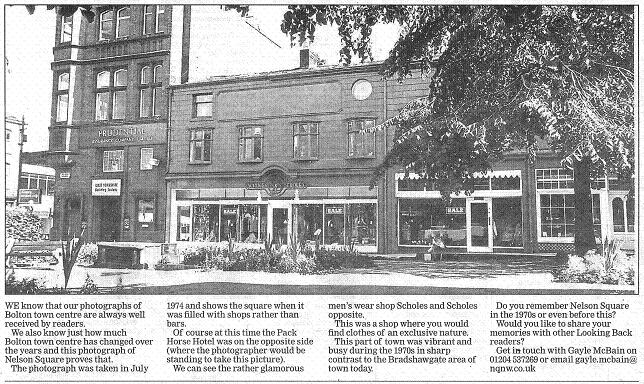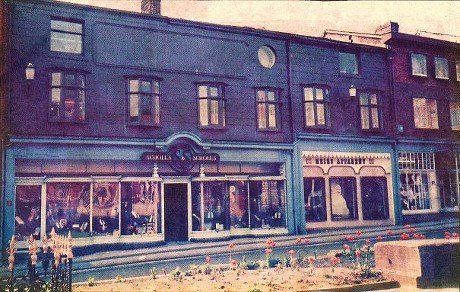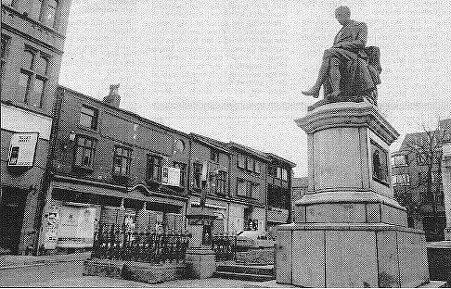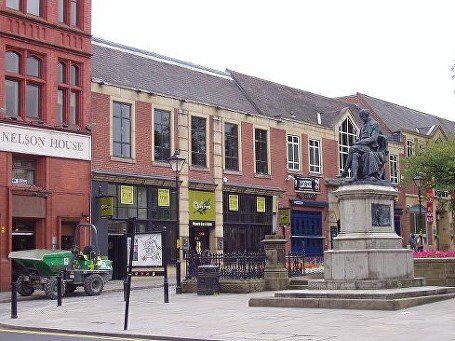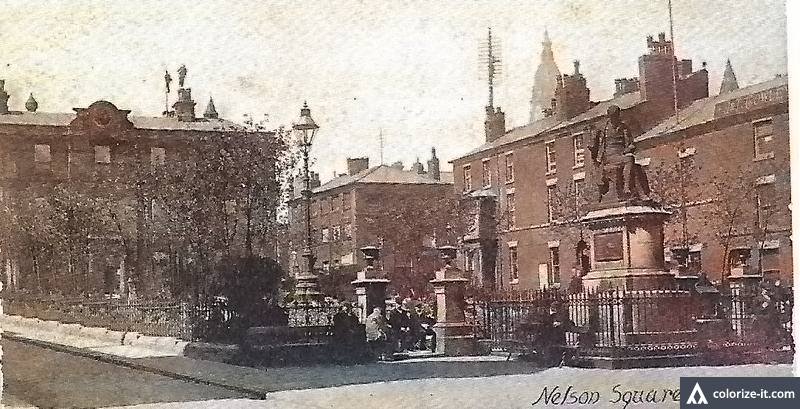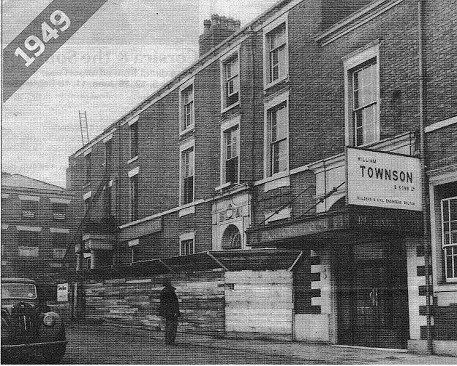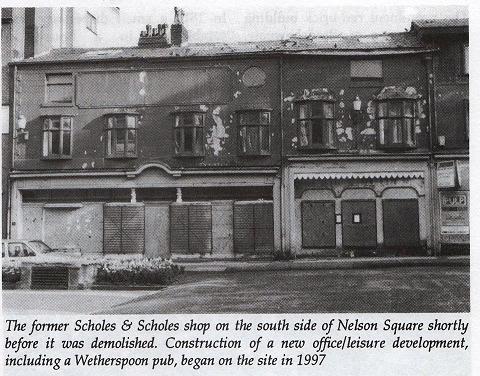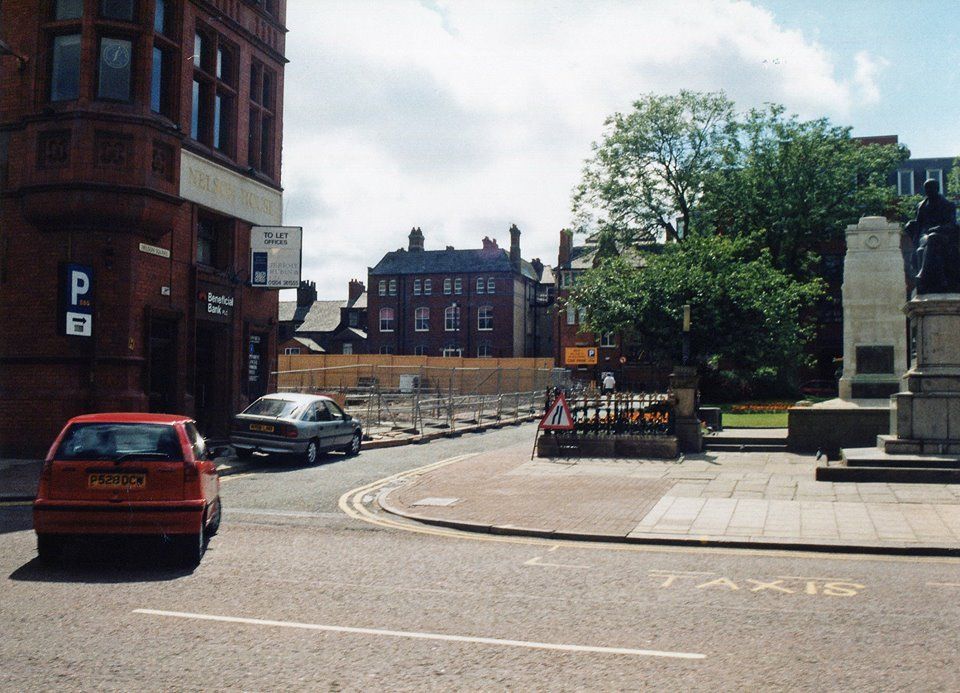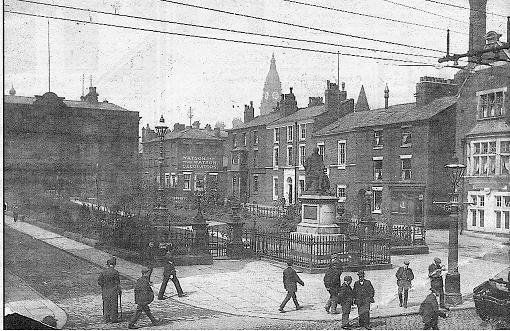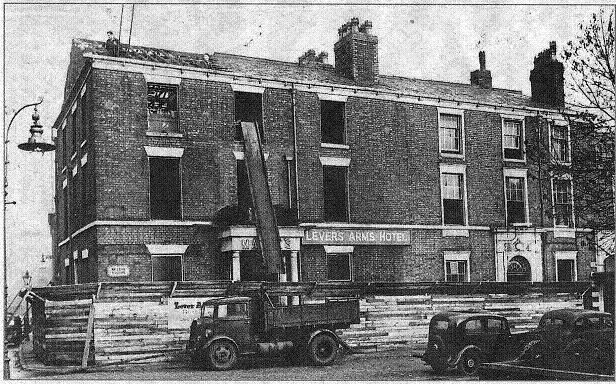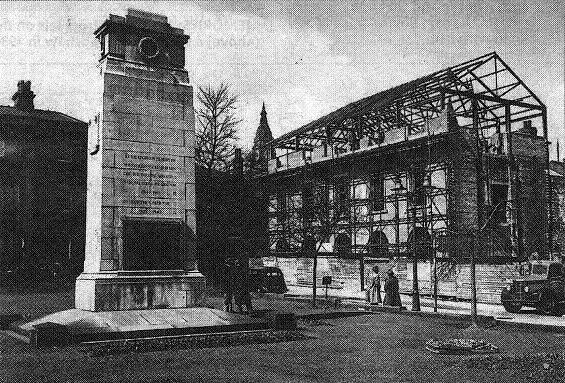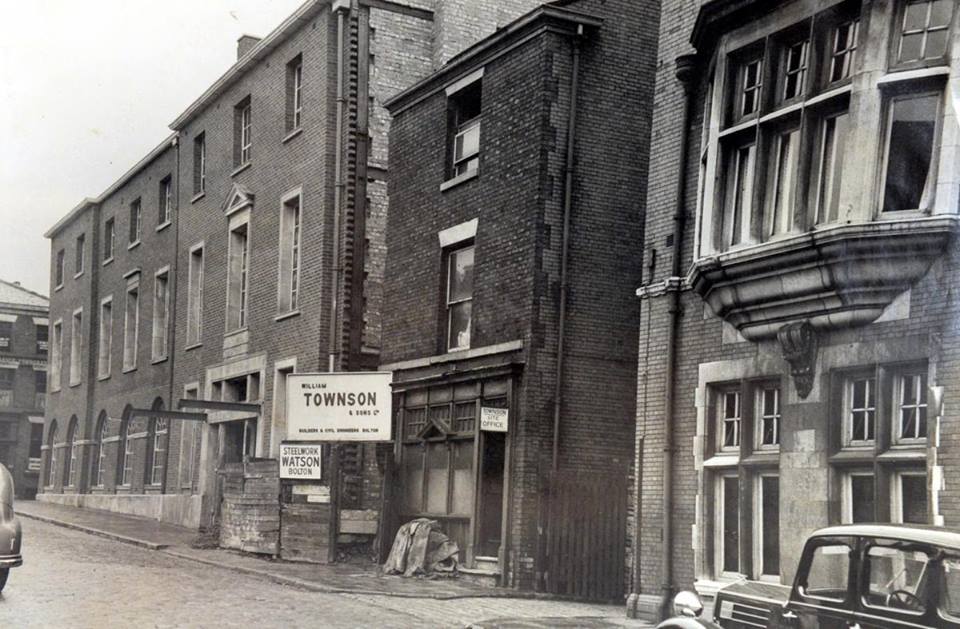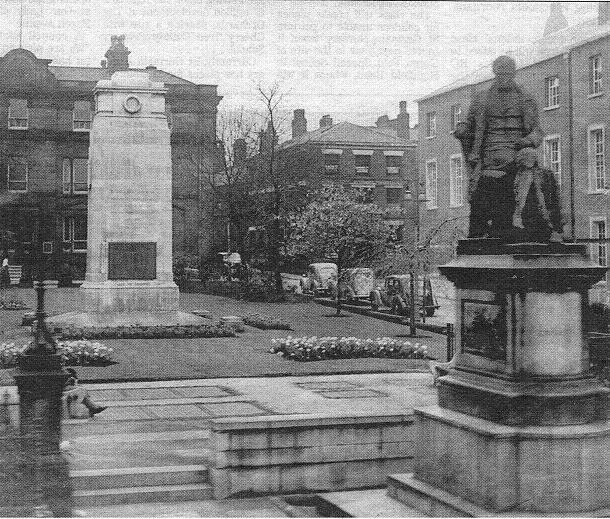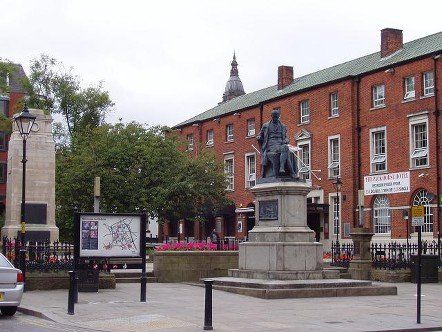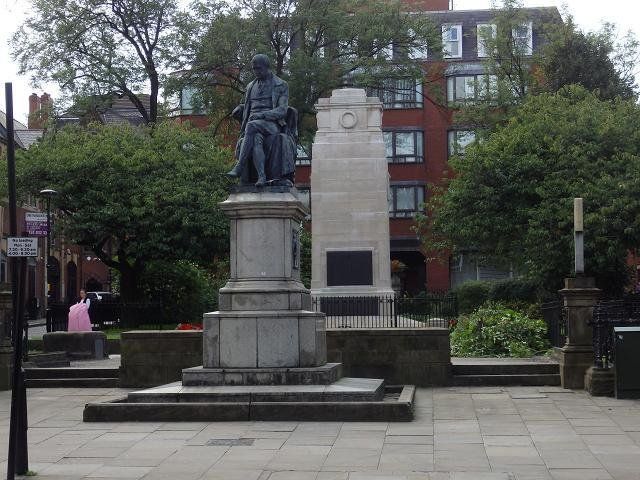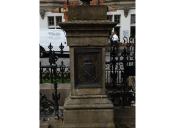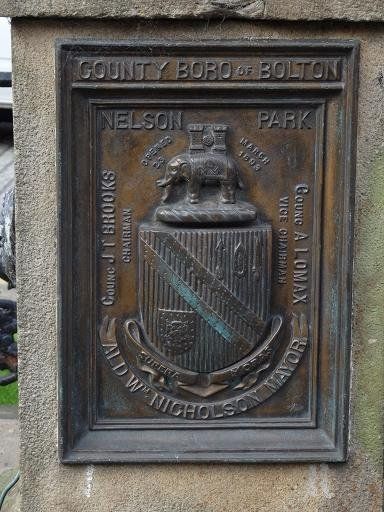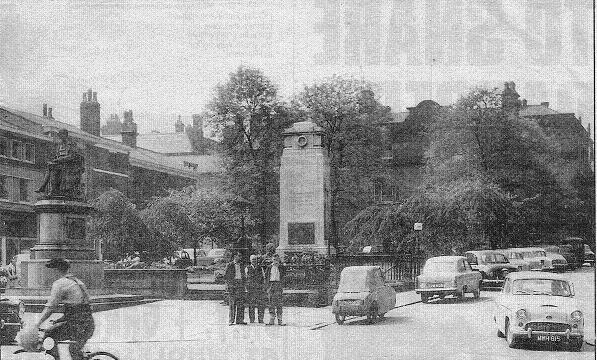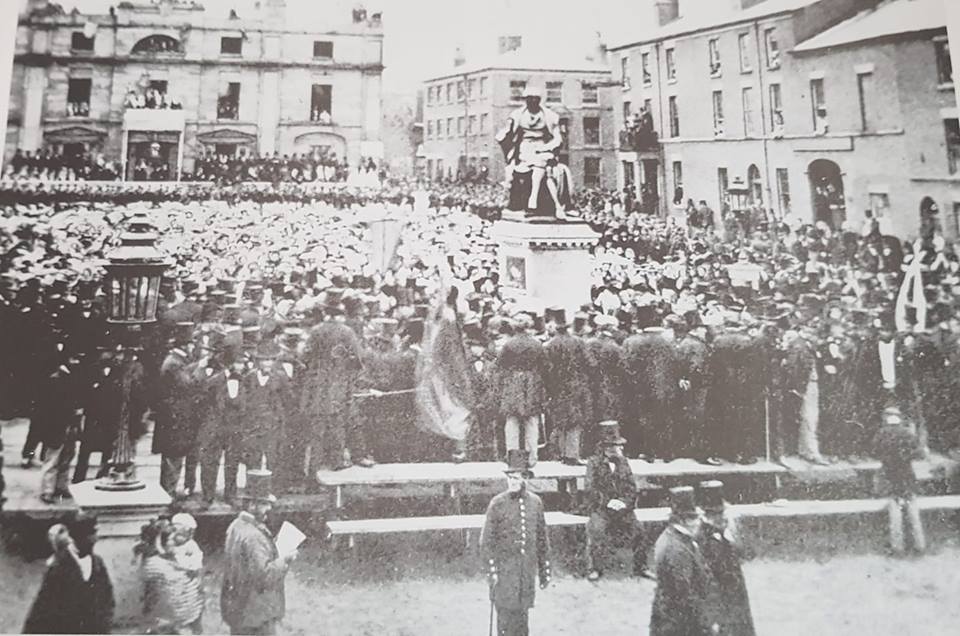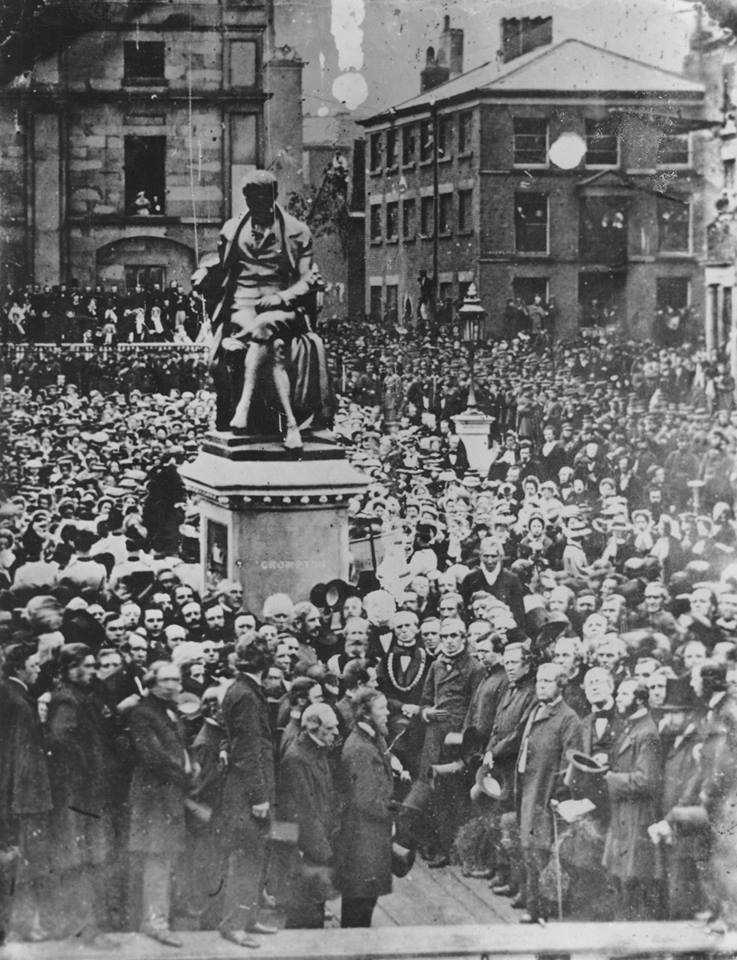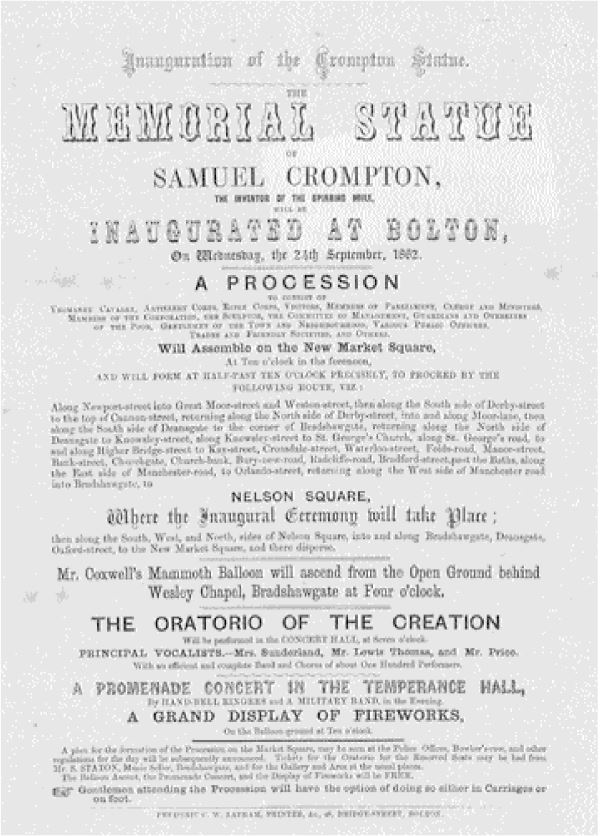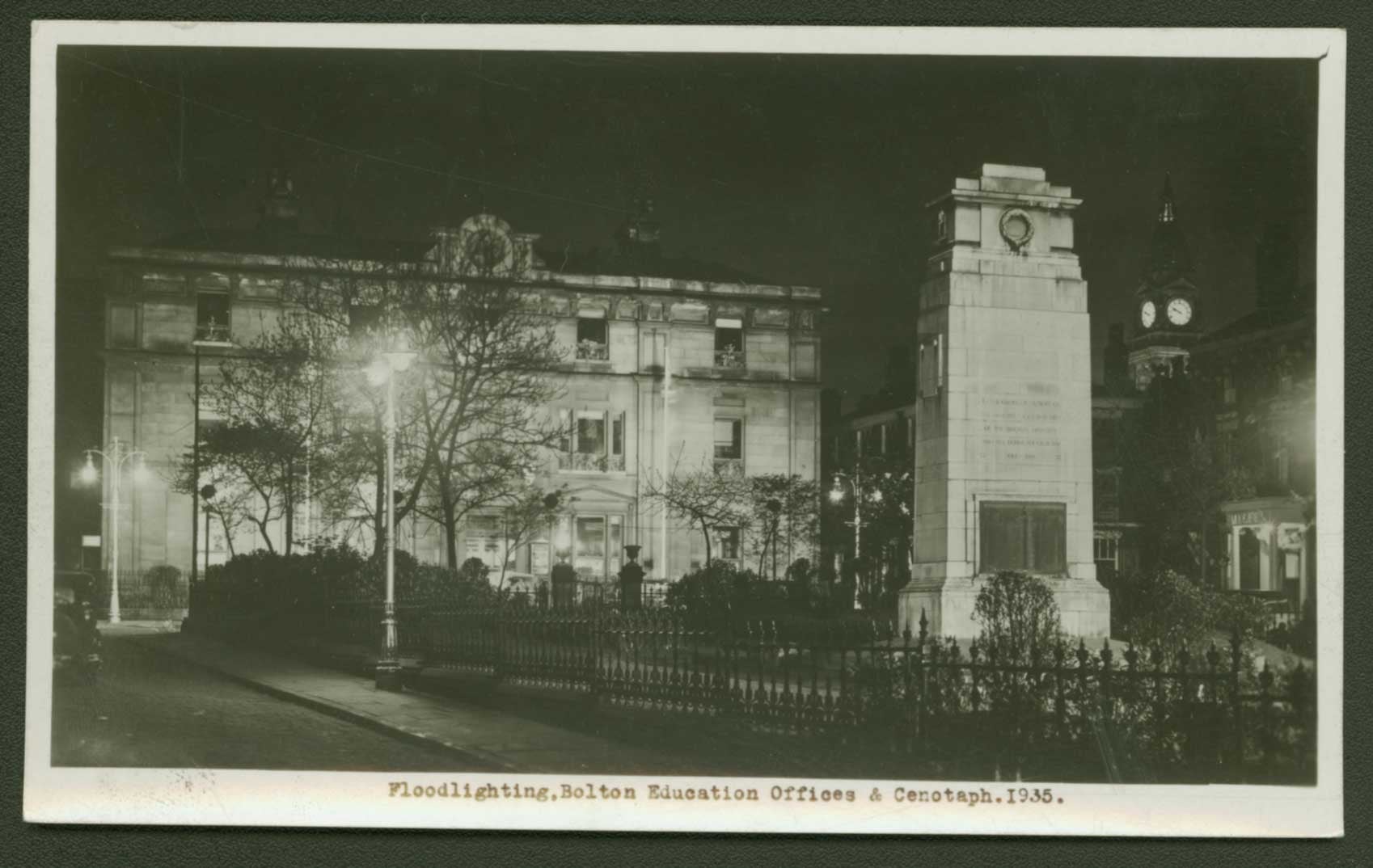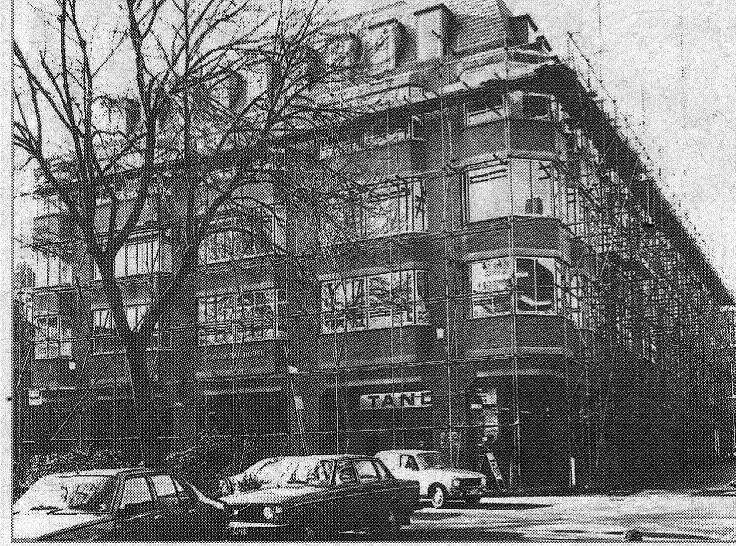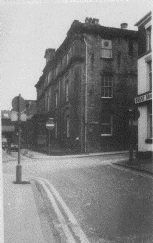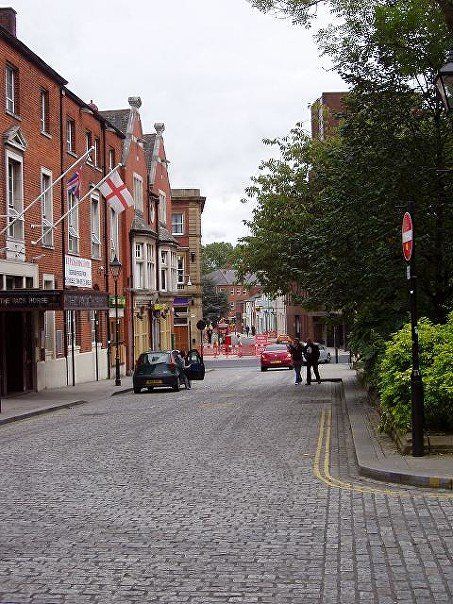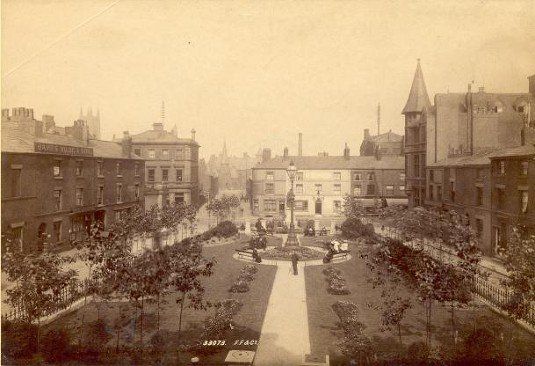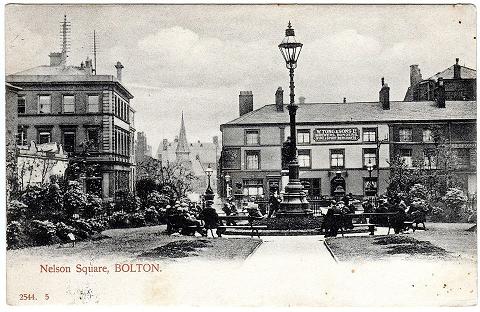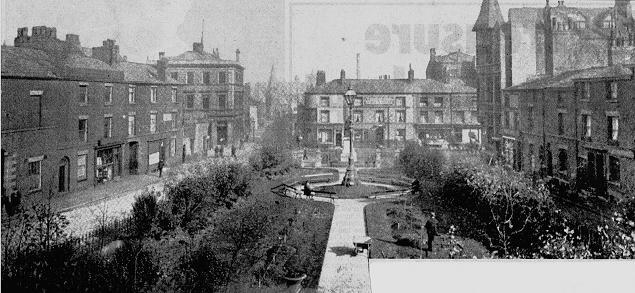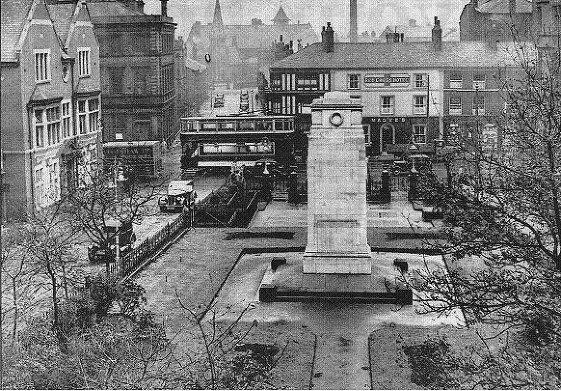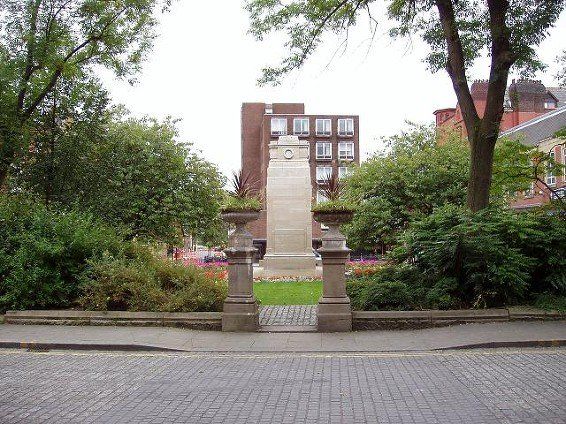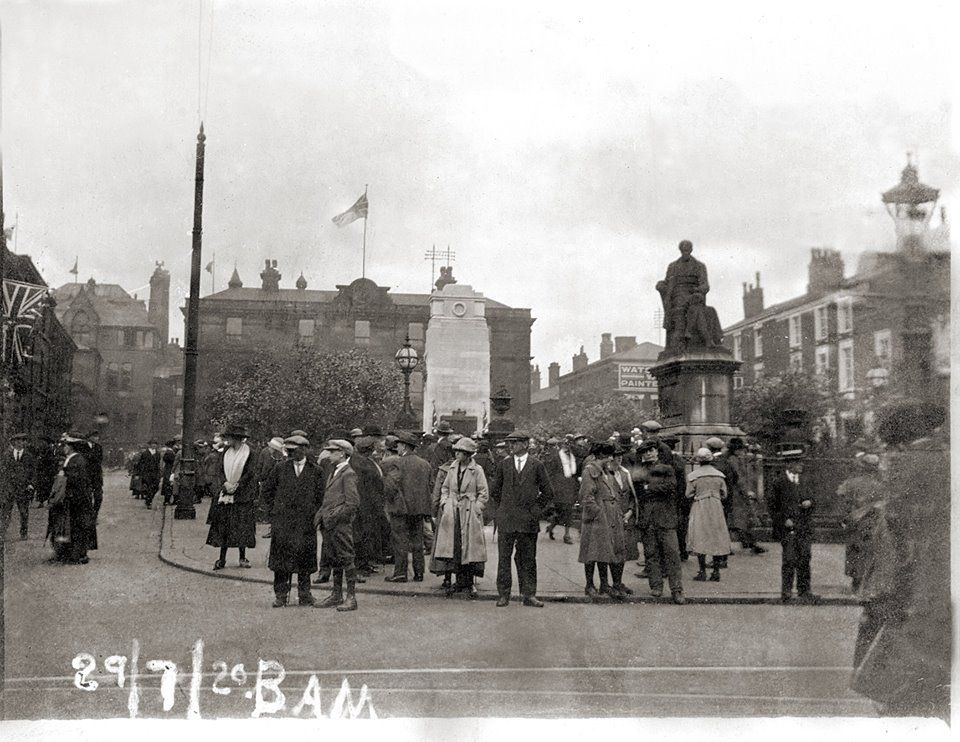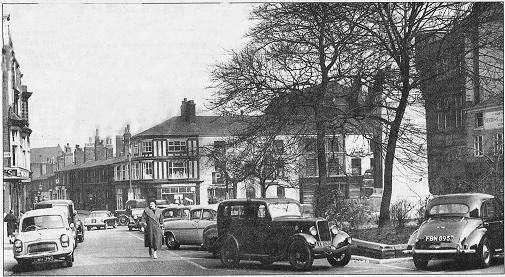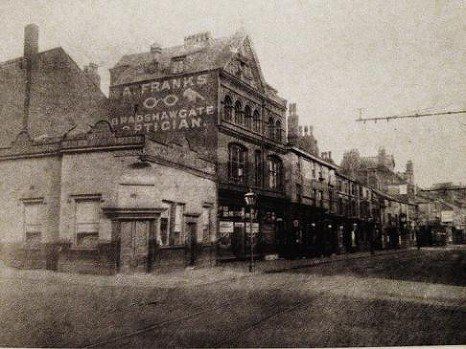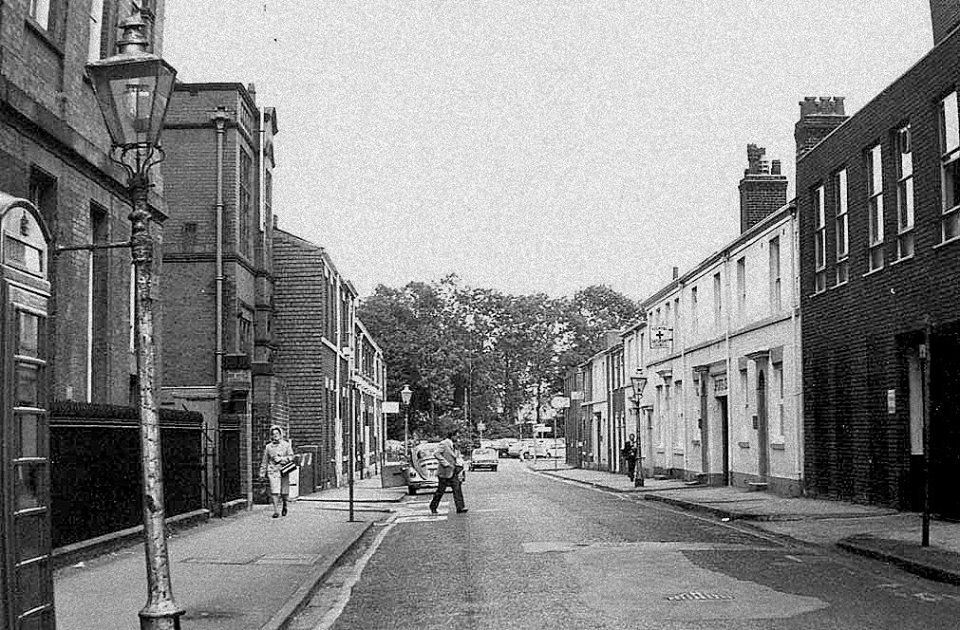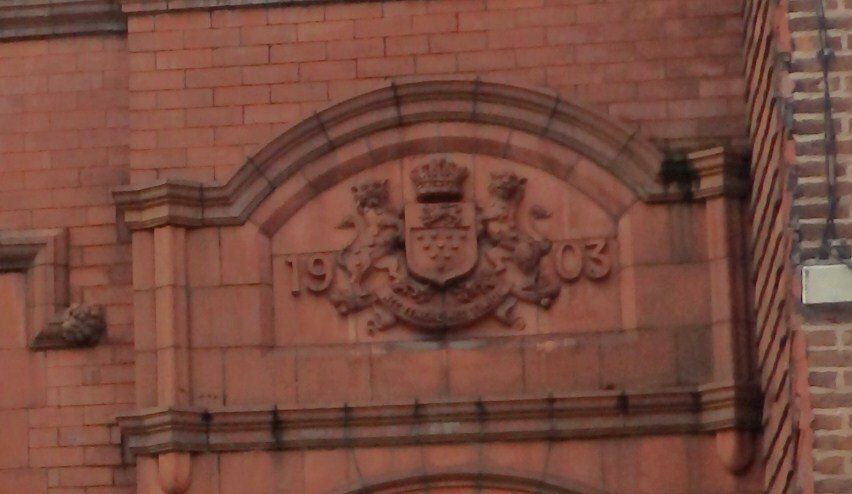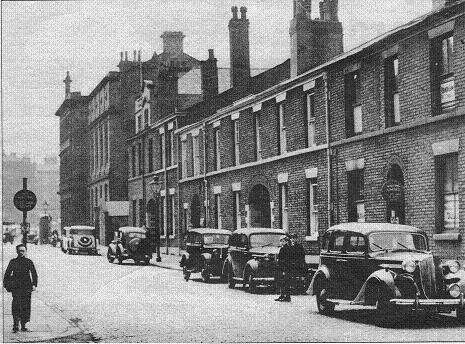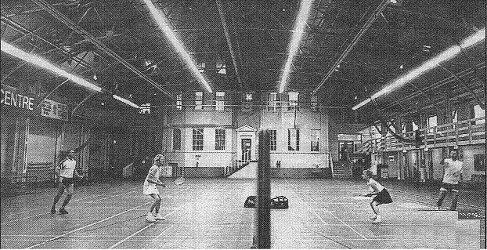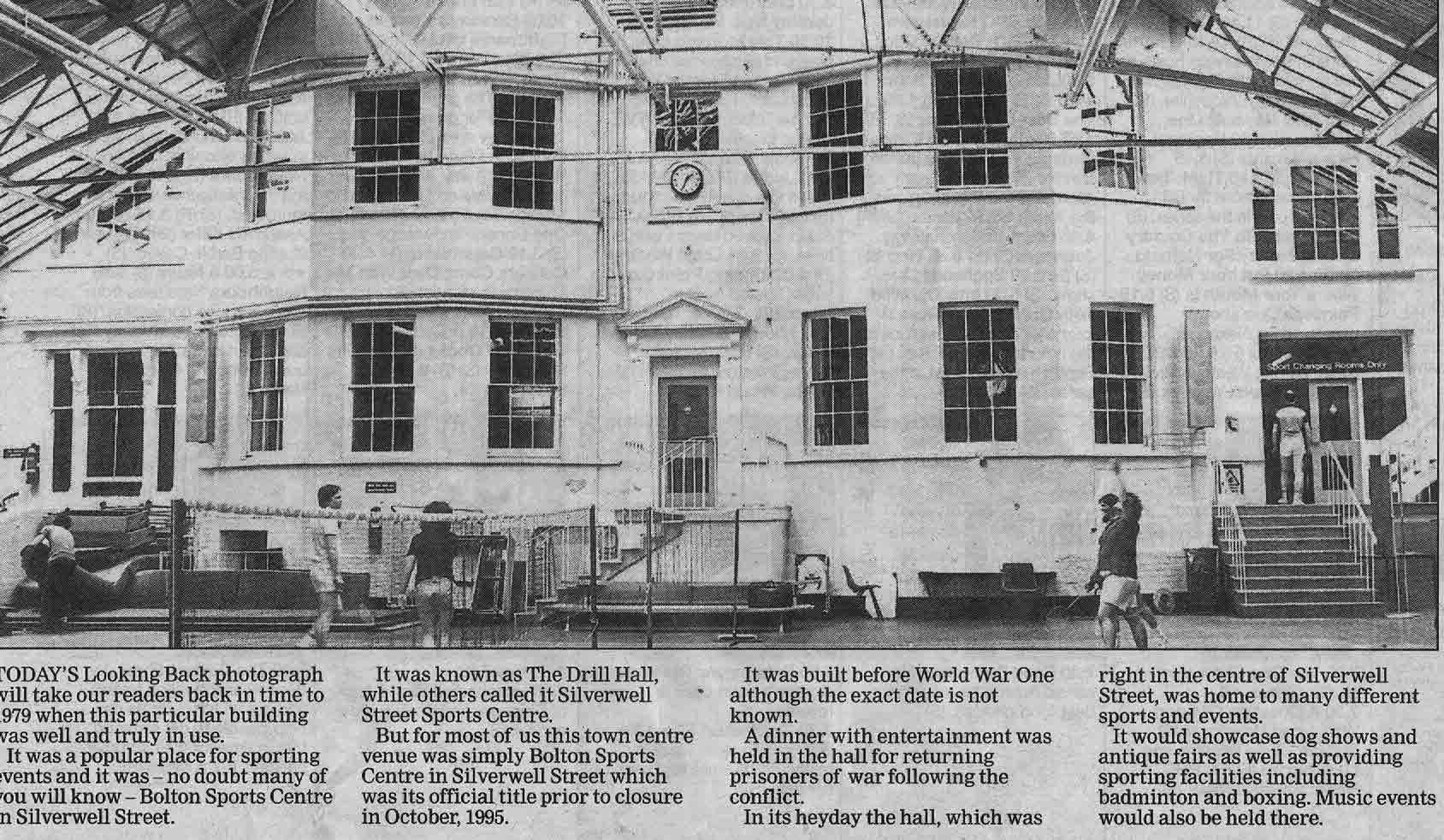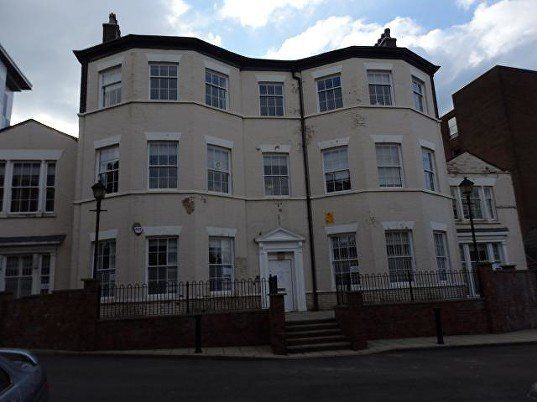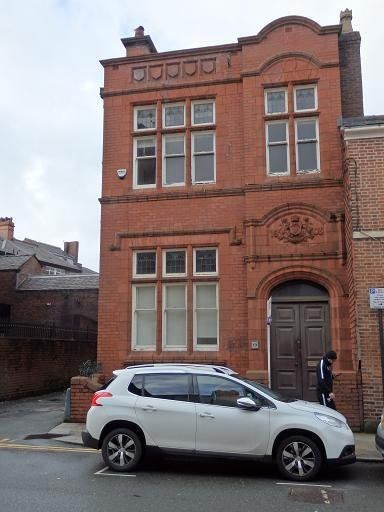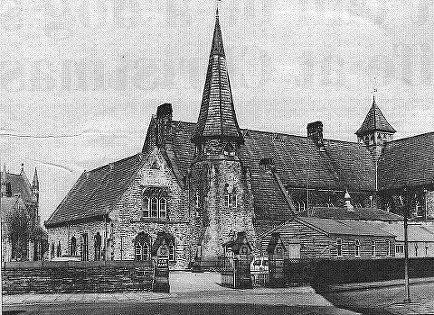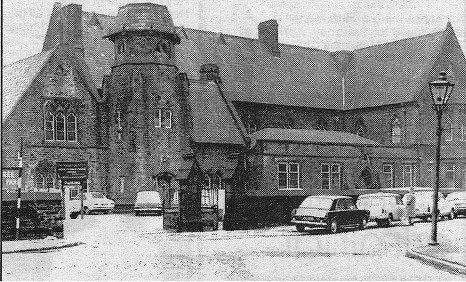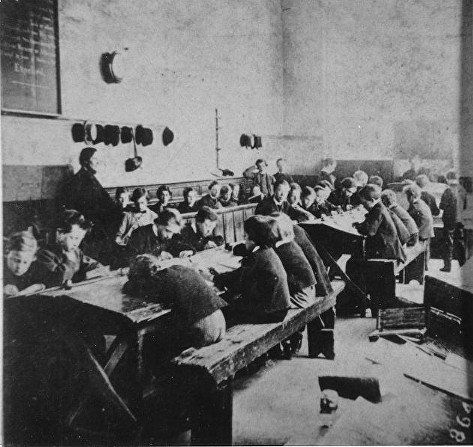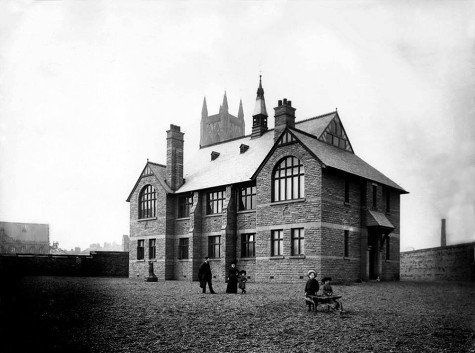Bradshawgate with Nelson Square on the left. The widening of Bradshawgate and the rebuilding of all the right hand side appears to be complete so this is after 1909. But in any case the cars suggest a date in the 1920s.
What is the car in the foreground doing? Perhaps the driver wants a word with the cyclists. Perhaps he is doing a three point turning in the middle of the main road. Any other suggestions written on a £10 note to my usual address please.
July 1974
Nelson Square in its hey day. The Prudential Assurance Company occupies the building built for it and Scholes and Scholes occupies most of the rest of that side of the square.
Scholes and Scholes the upper class men's outfitters in its hey-day. Next door - Heirs Apparent?
April 1997
Nelson Square, Scholes and Scholes, abandoned and derelict before redevelopment.
24 September 2009. (C) W D C
Redevelopment was started 1997. We have the Olive Press and Wetherspoon's "The Spinning Mule".
Nelson Square. Picture "colorized" and posted on Facebook by David Whenlock.
Picture at right>>>>>>
1930s Nelson Square with statue of Samuel Crompton who died 26th June 1827. The statue was unveiled in 1862. The terrace on the right contains the Lever Arms Hotel demolished in 1949 to make way for extensions to the Pack Horse completed in 1952. The lamp-post has made way for the cenotaph.
Quite a variety of headgear. Does the lady's hat make the picture 1920s not 30s?
Watson and Watson Decorators has become Watson Painters(?)
More about the statue lower down the page
The Levers Arms had been a substantial and not unattractive building. It would appear to have started life as two separate premises.
At left we are looking along Bowker's Row. >>>>>>>
Demolition complete giving a view through to Chancery Lane, back of Mawdsley Street. The Prudential Building has now been renamed Nelson House.
Picture (C) David Evans
At the far end of Nelson Square, the Provincial Building which had been Bolton's Infirmary (more details later). The Pack Horse was rebuilt in this form in 1904 and does not yet have its later extension. Samuel Crompton has pride of place but the centre of the Square is graced by an ornate lamp-post and we do not yet have a cenotaph (erected 1920). There are railings all round the Square.
<<<<<<<<December 1949
The Pack Horse had previously been extended as far as the Townson sign and is now about to take over the whole block.
THE Levers Arms Hotel, on the corner of Nelson Square and Bowker's Row, was probably built around 1830 and it was claimed to be the scene of balls for tradesmen and bachelors.
The demise of the hotel came when local brewers Magee Marshall & Co, owners of the Pack Horse, gradually expanded along the row and they finally bought out the Levers Arms to continue with the extension. The new Pack Horse opened in 1952 and the Levers Arms became the Regency Lounge. In later times it became Shawgates Cafe-Bar, but in 2009 the Pack Horse closed its doors and three years later became student accommodation. Photograph shows the start of the demolition work on the Levers Arms in December 1949.
<<<<< 1951
Work is well on with the final extension to the Packhorse.
1956 Picture posted on Facebook by Eric Robinson.
Work on the replacement of the Levers Arms Hotel is complete but this small original building remains for the time being. The small notices indicates that it is being used as the Townson site office.
Laura Halliday commented: The ginnel became a garage area and was where the laundry van used to go with laundry for 6 MacDonald hotels across the [[area?]].
The ginnel and the site office disappeared as the Packhorse extension was completed.
1952?
The Pack Horse now has its extension, we have a clearer view of the Education offices, there are no railings round the square.
29 September 2009 (C) WDC
On the left a glimpse of the new building which replaced the Education Offices
(C)WDC September 2016
A view of the Crompton statue and the cenotaph with the new building at the top of Nelson Square. Note the small pillars either side of the statue and plinth (far right of the picture; there is an identical one just on picture on the extreme left)
Click on image; navigate <> ; larger images may offer + to display full size, then click and drag; X to exit
24th September 1862
Unveiling of the Samuel Crompton Statue in Nelson Square. Samuel Crompton received almost no recognition in his lifetime even though there were ten times more "Mules" installed in Lancashire cotton mills than all other spinning machines combined. He died a poor man in Queen Street in 1827. Finally in 1862 his home town provided him with the recognition he should have had so much earlier.
This was the first civic statue in Bolton.
Bolton 1838-1938 Harold Hilton - The Crompton Memorial Committee unveiled the statue of the inventor, erected by public subscription on the 24th September 1862, and presented it to the Corporation for preservation and maintenance. The unveiling ceremony was attended by a vast concourse of people all ready to pay homage to the valuable work of Samuel Crompton.
Gilbert James French local textile merchant and antiquarian researched Crompton and lectured on him at Bolton Mechanics Institute, concluding that Crompton had been shamefully neglected by the town. The lecture sparked discussion and debate in the press with proposals including a Crompton literary and scientific institution, the purchase of Hall it's Wood, and the erection of a statue. The institution was favoured but was eventually abandoned and the statue idea revived in 1860. The William Calder Marshall statue was made of electroplated copper by Elkingtons in Birmingham.(quoted by D McCann)
Pictures 2,3,4 posted on Facebook by Denis McCann
At the top end of Nelson Square, the Provincial Building with Infirmary Street to its right.
A public dispensary had been established in Mawdesley Street in 1814, then an infirmary in Nelson Square a decision to build it having been taken in 1827. It was built with seven beds but was eventually extended to have 40. It closed when the Bolton Infirmary (later Bolton Royal Infirmary) was opened in 1883. In the mid 1900s it was the Education Offices but was demolished and re-developed around 1980 as offices, restaurant and Tandy’s. Tandy’s closed and in 2011 was “the bar”.
From Bowker's Row looking across the front of the Provincial Building with the gardens of Nelson Square on the left.
Looking the opposite way along Bowker's Row around 1960,62. This part has now been replaced by the Crompton Centre (Arndale Centre).
Old postcard (from the collection of David Whenlock?) from the top of Nelson Square (probably from the infirmary)
At the far end of the block on the left is a single storey building which is the Packhorse before its rebuilding in 1904.
Above the block can be seen the top of the Parish Church tower. On the corner of Bradshawgate and Silverwell Street is the old GPO. Dimly at the far end of Silverwell Street is the Parish Church Institute.
The Prudential Building (Now Nelson House) still has its hat on. The centre piece of the Square is the ornate lamppost. Bolton had a number of these, on Victoria Square, at the Chadwick Orphanage and at the junction of Blackburn Road and Belmont Road are some examples.
1904 Postcard from the collection of David Whenlock
A clearer view from the centre of the square.
The notice says "W Tong and Sons Ltd, Brewers, Bonders, Wine and Spirit Merchants". This is not yet obviously the Red Cross Hotel.
On the left corner of Silverwell Street is the old GPO.
Opposite it, on this side of Bradshawgate note the single storey of the original Packhorse.
A wider view at about the same time as the picture above. We note the buildings either side of the Square and note that the Prudential still has its hat on.
1936
The Cenotaph built in 1920 to commemorate Bolton Artillery has now replaced the lamppost. The gardens are still surrounded by railings.
The licensed premises are now the Red Cross Hotel licensed by Magees. This building was demolished in 1964.
The Packhorse has, of course, been rebuilt.
Look down Silverwell Street to the Church Institute School, which became Canon Slade School until its move up Bradshaw in 1955/6.
In 1936 the Transport Committee wanted to turn Nelson Square into a bus station.
29 September 2009 (C) WDC
The gardens from the top of Nelson Square. Pity I could not take the picture from the roof.
The Red Cross Hotel and the other building on that corner of Silverwell Street have been replaced by the building behind the cenotaph. On the right we catch a glimpse of the Prudential Building and the Wetherspoons pub which replaced Scholes and Scholes.
The low stone walls round the gardens have evidence of the previous railings, probably removed like so many others during the second world war.
29th July 1920 (C) Steve Gill whose Grandfather took the picture.
The Dedication of the Nelson Square Cenotaph.
March 1960
The Red Cross still bears that name.
The Prudential Building is still occupied by the Pru.
March 2020 (C)WDC
I almost like that building though when you look along Bradshawgate past it, towards Preston's it is so out of character and just adds one more oddity to the street.
The view of course is from half way up Nelson Square looking to the Crompton statue on the right, what has been called the Connect Four building on the corner of Silverwell Street and part of Silverwell Street.
29 September 2009 (C)WDC
A look down that side of Nelson Square before we cross Bradshawgate into Silverwell Street.
The Packhorse on the corner of Bradshawgate and Nelson Square 1902. It had originally been a three storey building but the upper storeys had been removed.
20 September 2016 (C) WDC
Top corner of Nelson Square. Infirmary Street is to the left and the side of Nelson Square adjacent to the Packhorse on the right. Straight on is Bowker's Row with St Andrew's Church, now St Andrew's shopping boutique. Bowker's Row once ran through to Fold Street. On this picture it stops against the Crompton Place shopping centre on Exchange Street.
Silverwell Street
Silverwell Street c1970
On the right the drill hall (sports centre) then the Hospital Saturday office. Lower down the street on the left Georgian houses with archways through which you would have driven your horse and carriage.
One such archway accessed the rear of 16 Wood Street.
On the left note the building where the woman is walking.
This building had been built as the Earl of Bradford's Bolton Estates Office.
At left, his crest. "nic temere nic timide" neither rashly nor timidly.
It's an OK building using the terra-cotta which is quite common in Bolton's town centre but it jars with the rest of this Georgian street.
Silverwell Street c1950
looking back towards Bradshawgate and Nelson Square.
Old cars, No waiting his side today, there were a lot of those signs, somebody had to come round and swap them over early every morning so parking could be on opposite sides of the street on alternate days. Georgian houses, the arch ways were for horses and carriages to the back of Silverwell Street and Wood Street. The building on the corner of Bradshawgate is the old GPO occupied from about this time by Ordnance Survey
The Estates Office is visible but is set back slightly behind the rest of the row.
On the right as you go down Silverwell Street from Bradshawgate was the Drill Hall, or the sports centre as some will remember it.
The Drill Hall was built 1886, and was still in use by the TA in 1960, probably later. It hosted the Dog Show every New Year, Ideal Home Exhibitions etc and became the Silverwell Sports Centre. There was a great outcry when it closed for that purpose before Excel at the Manchester Road College was ready. Now the Tech has been demolished and you can use a gym at Bolton One – the Sir Jason Kenny Centre.
It always seemed odd that the inside wall at one end was in fact the outside wall of a house – Silverwell House and the Drill Hall had been its garden. There is now a new building fronting onto Silverwell Street but the site behind has been cleared and the front of Silverwell House has been restored and is again the front wall of a house. Silverwell House was built in 1790 for John Pilkington, a cotton manufacturer.
Pictured in 1979.
The front of Silverwell House pre 1886 before the garden was roofed in for the Drill Hall.The gentleman in the top hat is presumable John Pilkington.
Silverwell House was the home of Bolton High School for girls, 1880-1 which eventually became Bolton School Girls’ Division.
It looks pretty much like that again now.
(C}WDC September 2016
Silverwell House restored to its pristine splendour.
At the bottom of Silverwell Street as it bends towards Churchgate is the Church Institute building in the grounds of the Parish Church. It was designed in a Gothic style by R.H Potter and opened in 1855.
The Church Institute School in Silverwell Street was founded in 1855 by the Reverend Canon James Slade to help the poor. It was re-named Canon Slade Grammar School in 1946 when it had about 350 students. It moved to Bradshaw Brow in 1956(?) and is now a comprehensive school with 350 sixth form students from a total enrolment of 1700.
This later became Canon Slade School named after the Vicar of Bolton, 1817-56. The Church Institute became Cannon Slade School in 1946; the School moved to Bradshaw Brow in 1959.
Also in the parish church grounds at some time was Bolton Grammar School (for boys).
Pictures 1,2 and 3 were supplied by Ged Melia and have probably not previously appeared on-line. Pictures 2 and 3, interior scenes of boys in class, it can be verified that these are in that building by comparing inside and outside views of the large gable window. Picture 1 - playtime.
In picture 4 the new Parish Church can be seen close to completion. So this is earlier than the Church's Consecration in 1871.
This picture is from the 1880s. This building seems to be slightly further away from the Church than the older building and they could both have existed together.
The school moved to Chorley New Rd in 1899 and became known as Bolton School with the Bolton Girls' Grammar School joining it as part of Lord Leverhulme's foundation.
This building is not visible in the previous Church Institute two pictures. It may have been replaced by the Church Institute School or simply demolished before those pictures above were taken.
There is a stump in front of the left hand gable. This may be the original Bolton Market Cross which currently stands in the grounds of the present Bolton School.
On the next page we continue our travel along Bradshawgate calling in at Fold Street and Wood Street.


